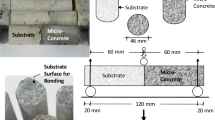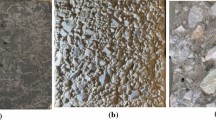Abstract
The use of the pull-off test to evaluate the interfacial bond strength between substrate concrete and bonded materials can result in failure of the concrete substrate without clear indication of the interfacial bond strength. Proper knowledge of the interfacial bond strength between a repair material and concrete substrate is critical for the selection of repair materials and for the modeling of the performance of the composite section. This includes ultra-high performance concrete (UHPC) used for thin bonded overlays of concrete bridge decks. The bond strength of UHPC to concrete substrate sections was evaluated in this study using the pull-off test, a modified version of the pull-off test, and the modified splitting tensile strength test. The results identified some challenges with respect to the characterization of interfacial bond and associated variability of test results. A new test method proposed to determine the interfacial bond strength showed that bond strength can range between 2.3 and 3.5 MPa and low coefficient of variation of 1.4% and 3.4%, respectively.







Similar content being viewed by others
References
ACI Committee 546 (2006) Guide for the Selection of Materials for the Repair of Concrete. American Concrete Institute, Farmington Hills
Graybeal B (2011) Ultra-high performance concrete. FHWA Publication No: FHWA-HRT-11-038. U.S. Federal Highway Administration, McLean
Russell HG, Graybeal BA (2013) Ultra-High Performance Concrete: A State-of-the-Art Report for the Bridge Community. Technical Report No. FHWA-HRT-13-060. U.S. Federal Highway Administration, McLean
Aitcin PC, Delagrave Y, Beck R (2000) A 100-m high prefabricated concrete pole: why not? In IEEE 9th international conference on transmission and distribution construction, operation and live-line maintenance proceedings, pp 365–374
Graybeal BA (2005) Characterization of the behavior of ultra-high performance concrete. Ph.D. Dissertation, University of Maryland, College Park, MD
Roy M, Ray I, Davalos JF (2013) High-performance fiber-reinforced concrete: development and evaluation as a repairing material. J Mater Civ Eng 26(10):401–407
Emmons P, Vaysburd A (1996) System concept in design and construction of durable concrete repairs. Constr Build Mater 10(1):69–75
Sprinkel MM (2004) Performance specification for high performance concrete overlays on bridges. Report No. VTRC 05-R2. Virginia Center for Transportation Innovation and Research, Charlottesville
Carbonell M (2012) Compatibility of ultra high performance concrete as repair material: bond characterization with concrete under different loading scenarios. M.S. Thesis, Michigan Technological University, Houghton, MI
Espeche AD, Leon J (2011) Estimation of bond strength envelopes for old-to-new concrete interfaces based on a cylinder splitting test. Constr Build Mater 25(3):1222–1235
Shann SV (2012) Application of ultra high performance concrete (UHPC) as a thin-bonded overlay for concrete bridge decks. Department of Civil and Environmental Engineering, Michigan Technological University, Houghton
Harris DK, Sarkar J, Ahlborn TM (2011) Characterization of interface bond of ultra-high-performance concrete bridge deck overlays. Transportation Research Record 2240. Transportation Research Board, Washington, DC
Vaysburd AM, Sabnis GM, McDonald JE (2001) Interfacial bond and surface preparation in concrete repair. ICJ 75(1):27–33
Tschegg EK, Ingruber M, Surberg CH, Münger F (2000) Factors influencing fracture behavior of old-new concrete bonds. ACI Mater J 97(4):447–453
Vaysburd AM, McDonald JE (1999) An evaluation of equipment and procedures for tensile bond testing of concrete repairs. Technical Report REMR-CS-61. US Army Corps of Engineers, Waterways Experiment Station, Vicksburg, p 75
Bonaldo E, Barros JAO, Lourenco PB (2005) Bond characterization between concrete substrate and repairing SFRC using pull-off testing. Int J Adhes Adhes 25:463–474
ASTM C1583, C1583M-13 (2013) Standard test method for tensile strength of concrete surfaces and the bond strength or tensile strength of concrete repair and overlay materials by direct tension (pull-off method), annual book of ASTM standards. ASTM International, West Conshohocken
Valipour M, Khayat KH (2018) Coupled effect of shrinkage-mitigating admixtures and saturated lightweight sand on shrinkage of UHPC for overlay applications. Constr Build Mater 184:320–329
Bassam TA, Bakar BH, Johari MM (2013) Characterization of the interfacial bond between old concrete substrate and ultra high performance fiber concrete repair composite. Mater Struct 46(5):743–753
Carbonell M, Miguel A (2012) Compatibility of ultra high performance concrete as repair material: bond characterization with concrete under different loading scenarios. Michigan Technological University, Houghton
Khayat KH (1992) In-situ properties of concrete piles repaired under water. ACI Concr Int 132:835–872
Robins P, Austin S (1995) A unified failure envelope from the evaluation of concrete repair bond tests. Cem Concr Res 47(170):57–68
Bao Y, Valipour M, Meng W, Chen G, Khayat KH (2017) Distributed fiber optic sensor-enhanced detection and prediction of shrinkage-induced delamination of ultra-high-performance concrete overlay. Smart Mater Struct 26(8):085009
Acknowledgements
The authors acknowledge the financial support provided by Missouri Department of Transportation (Grant Number: TR2015-03) and the RE-CAST (Research on Concrete Applications for Sustainable Transportation) Tier-1 University Transportation Center (UTC) at Missouri University of Science and Technology (Grant Number: 00046726).
Author information
Authors and Affiliations
Corresponding author
Ethics declarations
Conflict of interest
The authors declare that they have no conflict of interest.
Additional information
Publisher's Note
Springer Nature remains neutral with regard to jurisdictional claims in published maps and institutional affiliations.
Rights and permissions
About this article
Cite this article
Valipour, M., Khayat, K.H. Debonding test method to evaluate bond strength between UHPC and concrete substrate. Mater Struct 53, 15 (2020). https://doi.org/10.1617/s11527-020-1446-6
Received:
Accepted:
Published:
DOI: https://doi.org/10.1617/s11527-020-1446-6




